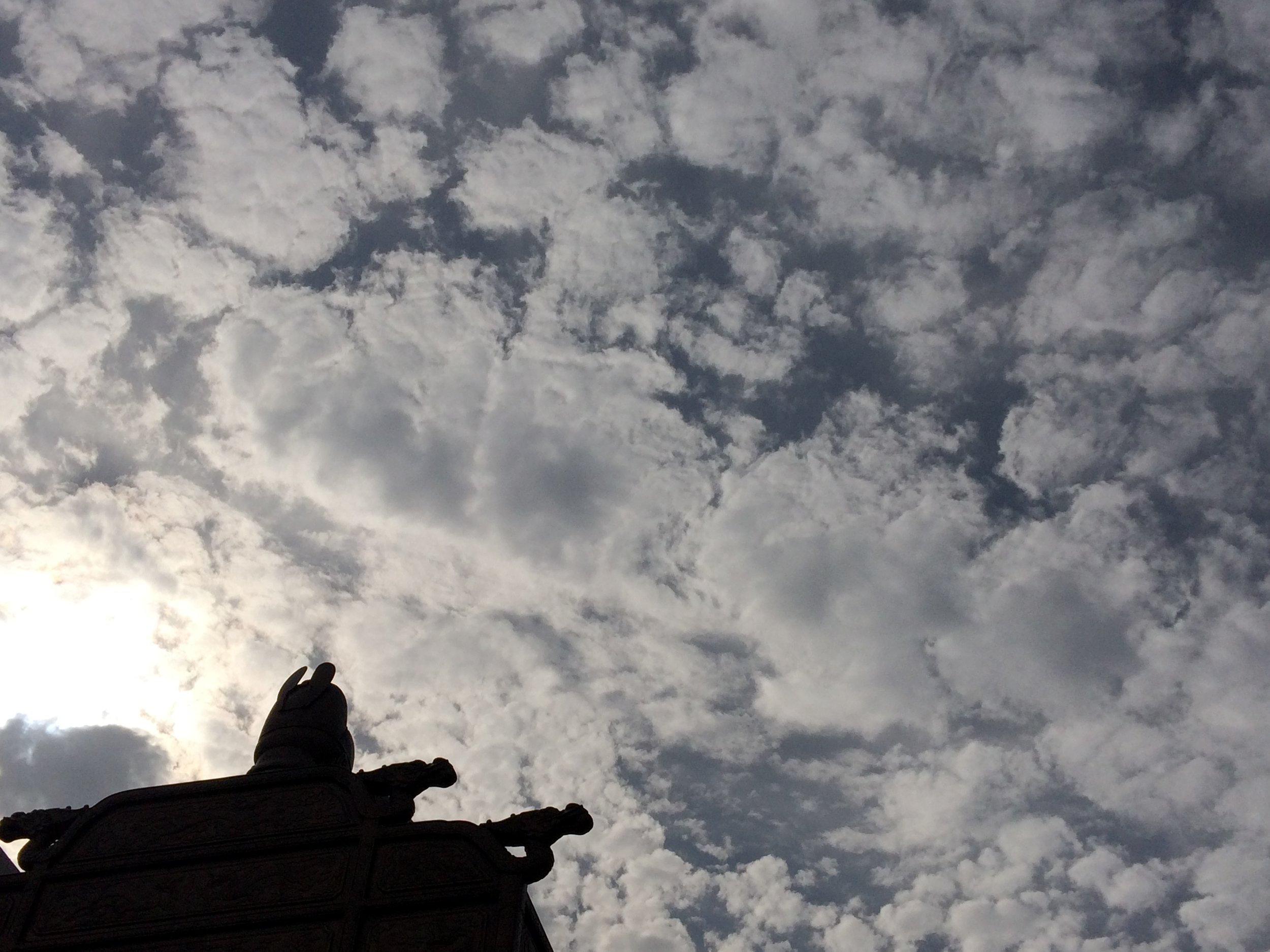If you think that the sounds of South Korea are all about K pop - think again.
The country has a wealth of fabulous soundscapes to discover - whether you're out and about in Seoul ...
or exploring the country's farmland, mountains, temples and coastlines.
Check in with this page over the next few weeks to hear short audio samples from a range of locations:
Listen with good headphones - many of these recordings are in binaul stereo
Binaural Stereo ... the next best thing to BEING there.....
Pungmullori 풍물 놀이 is a form of farmer's music which uses lively percussion with the piercing melodic thread of a taepyongso 태평소 – a double reed wind instrument in the oboe family. This music is performed in villages at various farm festivals – one of the original purposes was to energize people as they worked in the fields. After a day of foot slogging around the beautiful palace buildings of Gyeongbokgung and surrounding neighborhood, my guide and I both agreed that indeed we really did feel a new surge of energy from listening to this band – who were performing in central Gwanghwamun Square as part of a weekend celebration of Korean music and culture.
Audiophile tip: if you want to hear a wealth of traditional Korean culture search the internet for cultural festivals coming up in the areas you plan to visit. Festivals are especially prevalent in the fall (September/October).
Original recording September 2016 in 48KHz/24 bit depth, glorious binaural stereo.
This is a downsampled mp3 version - please contact me for info on access, rights & rates for commercial use of my recordings.
A visit to Gyeongbok 경복Palace 궁 in central Seoul is a must. Changing of the guards happens four times a day starting at 10am.
Its not just a great visual display of Joseon era tradition - it a sonic spectacle too with the marching band and giant drums.
Audiophile tip: it can be tricky to hear a 'clean' soundscape at these types of events - there's often an announcer on loudspeakers talking across much of the otherwise lovely sonic action. If you can stand where such a procession begins - or ends - and get as close as possible to the action, you'll experience the best sound.
This is a downsampled mp3 version of the original 48KHz/ 24 bit depth binaural stereo recording.
Contact me regarding any use - or purchase of recordings for commercial & other purposes: di.hope@live.com.
You don't have to go far in South Korea to find a Buddhist Temple. Most of the are in the mountains - that's largely because during the long period of Confucianism,Buddhist's retreated to the mountainous countryside to be able to practice their religion in peace.
This temple - Sinheungsa 신흥사 (pronounced 'Shin-hung-sa') is in the beautiful Soraksan 설악산 National Park - a mountainous area near Sokcho on the north east side of the country. The recording (a short sample of a much longer recording) was made very early one autumn morning - and includes the monks chanting and a huge, ancient brass bell.
Audiophile tip: to experience theses kinds of soundscapes first hand think about doing a 'temple stay' - available at most temples in South Korea and a great way to experience the more meditative side of Korean life. But for the best sonic moments be ready to get up early - my Korean film maker friend & I got up at 3:30am to capture this one.
Recorded in 48KHz / 24 bit depth binaural stereo. Please contact me to use this recording for any commercial or other purposes - longer playing soundscapes and signature sound recordings available for purchase. Email: di.hope@live.com
If you have any extra time when you're in the vicinity of Gyeongbok Palace, for a modern day food market experience make sure to stop by Tongin Market. To get there from Gyeongbukgung Station, exit 2, walk straight up Tongin Dong and an entrance to the market will appear on your left in less than 10 minutes. Established in 1941 for the then Japanese residents of the area, it quickly came into Korean hands after the war ended. The market consists of a long roofed corridor, no wider than an alleyway, so the sounds really resonates.
There are a variety of shops - including one or two delightfully cluttered 'general goods' type stores, but the focus is on Korean food. I found I could pay with Korean Won but the market operates a special coin/token system. Pay W5,000 at the Customer Service Center in the center of the market to receive a tray with a string of coins each worth W500. Food dishes range from W500 (1 coin) to W1000 (2 coins) with just a few being as much as W1500 (3 coins). Then sit at a stall & enjoy watching your food being cooked in front of you. This soundscape features a short walk through the market to give you a sense of the atmosphere.
Audiophile tip: take a walk down one of the side alleys near the top end of the market & just stand & listen. Its quieter there & you can hear Korean families in the small old-style houses, with strains of the latest daily K drama drifting from tv's through open doorways. A real sonic slice of local everyday life in Jongno-gu.
I have a wide variety of 'audio skylines', ambiences and other location recordings from around Seoulavailable to purchase if you need location background sound for your film, podcast or art project. For more information contact: di.hope@live.com
Hyehwa might not be as obvious of a Seoul district to visit as Hongdae or Gangnam - but there's lots to discover there, day or night. As well as many normal shops, blaring K pop & streets with busy traffic, there's art of all kinds & plenty of yummy street food. In the evenings street music can pop up anywhere ... on this evening as well as a full blown musical show on one of the main streets (half one side of which had been closed off for traffic & a stage erected right under a set of traffic lights) keep your ears open for buskers.
These hand pan players were located on a side road off the main pedestrian shopping street. They attracted an appreciative crowd - their music forming a little sonic oasis of shimmering metallic tones and shifting beats amongst the urban bustle. You'll really hear the movement of the stereo field in this binaural recording - just as you would if you were there and shifting your head around to take in all the sights while listening.
Audiophile tip: Gravitate towards any street performance - especially music. There's often marvelous sound to be heard completely free. Try circling around the act to find the spot where the urban acoustics make it sound best.
This is almost my favorite recording in Korean so far. But there were a few other soundscapes I encountered that completely captured the spirit of the country. Ever heard of 'Pansori'? Traditional Korean opera ... what - sounds like your idea of torture?! Nooo!!!
Think incredible and magical ... hear for yourself on Part 6 of Sonic Seoul.
Pansori (판소리) is Korean musical storytelling – kind of the Korean version of opera. It’s usually performed by just one singer or sorikkun (소리꾼) and a drummer or gosu (고수) playing a big deep, resonant barrel drum or buk (북). This music is named after the Korea word pan meaning "a place where many people gather" and sori or "sound".
Pansori was developed from the songs of shaman in the 17th century – and was somewhat refined to appeal to an upper class audience, but even so it still has strong strands of earthy Korean folk music traditions woven through it.
Infact … Pansori is often rather raunchy …. in this recording the singer is apparently describing some very vigorous sexual encounters with her secret lover in the forest – no wonder the audience were smiling!
Singing Pansori was very much a ‘men only’ occupation … until a singer called Jin Chae-seon came along in the mid 1800s. She was so incredibly talented that she trail blazed the way for women singers. Her story was made into the achingly sad & beautiful 2015 film called The Sound of a Flower.
This is the heart and soul of Korea distilled into one heady, intoxicating audio cocktail … extraordinary, unique – and intensely beautiful!
Audiophile tip: Unless you have a good understanding of the Korean language, you’ll need an English-speaking guide to really get the most from a pansori performance, so that you can follow along with the unfolding story.
But – as this recording switches from ordinary stereo to much more intimate binaural stereo, I’m sure you’ll find you don’t need any translation to hear just how skillfully the singer modulates the tone and rhythm of her voice to convey emotion.
Octopus seller in Jalgachi Market, Busan 부산 자갈치시장








